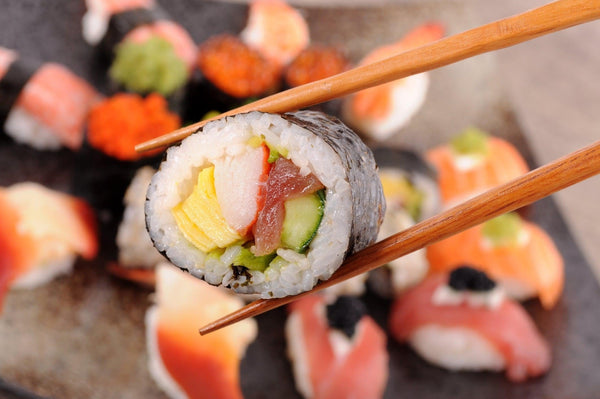
Jump to:
It wouldn’t be out of the ordinary to say that sushi is one of the most popular Japanese foods around the world. Sushi usually consists of a piece of raw fish placed over a portion of seasoned rice, but it can be easily customized and there are a ton of different ways to enjoy it.
While many people look forward to going to their favorite sushi restaurant or enjoying the authentic stuff when they visit Japan, it’s surprisingly easy (and fun) to make sushi at home! In this article, we’ll share 6 different sushi recipes and provide tips and tricks for recreating the best sushi experience at home along the way.
Making Sushi Rice

Many argue that when making sushi, the quality of the rice is more important than the quality of the fish. Therefore, starting with a good sushi rice base is super important! When it comes to the rice itself, Japanese short-grain rice is the ideal choice for sushi because it has a high starch content, giving it the perfect amount of stickiness.
Now that you know what kind of rice to use, how can you turn it into sushi rice? Well, first you have to cook the rice properly, which you can do by following our guides on cooking rice in a pot or in a rice cooker.
Next, you’ll have to season the rice. You can either use seasoned rice vinegar, or a mixture of sugar, salt, and unseasoned rice vinegar. Using your preferred seasoning(s), you can use our recipe to make the perfect sushi rice at home. Now that you’ve got your sushi rice, the sushi-making possibilities are endless.
Sushi Rice Water Ratio
The ideal water-to-rice ratio for sushi rice is typically 1:1. This means using 1 cup of water for every 1 cup of sushi rice. However, some variations may call for slightly more water, such as 1.2:1 (1 cup of rice to 1.2 cups of water), depending on the specific type of rice and your personal preference for texture. It's essential to rinse the rice thoroughly before cooking to remove excess starch and achieve the desired sticky yet firm consistency.
Choosing Sushi Ingredients & Toppings
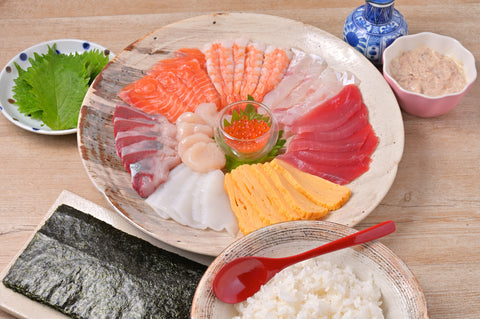
Next, you’ll need to choose your sushi ingredients and toppings. Depending on the style of sushi you’re making, you’ll most likely need some type of nori seaweed sheet. You’ll also need a good soy sauce and wasabi for dipping the sushi in, and maybe even (highly recommended) some pickled ginger.
But don’t forget about the toppings! Of course, you can use whatever you have or what is available to you, but here are some of our recommendations.
- Fish – Tuna, salmon, toro sashimi, and yellowtail are popular choices! Cooked shrimp also works really well. If you can’t find fresh seafood in your area, you can always go for canned tuna.
- Seafood – Cooked octopus and squid sashimi are also popular choices for sushi. Though some may find these options a bit outside of their comfort zones, they are popular sushi toppings in Japan. Eel (unagi) also tastes delicious if you can get your hands on it.
- Tamagoyaki – This sweet and savory egg dish is a must for us when it comes to sushi! You can also go for these premade shredded egg strips if you’re in a hurry.
- Vegetables – Avocado, cucumber, daikon radish sprouts, shiso, and pickled vegetables (tsukemono) are all great options. You really can’t go wrong with any of your favorite veggies though.
- Sauces – While soy sauce is usually the only sauce used for dipping sushi, you can of course use other sauces if you’d like. Want to add a citrusy kick to your sushi? Go for a ponzu sauce! Another unique dipping sauce idea would be this smoked soy sauce. Kewpie mayo is a popular condiment for sushi rolls, especially when paired with sriracha to make spicy mayo.
Sushi Making Tools
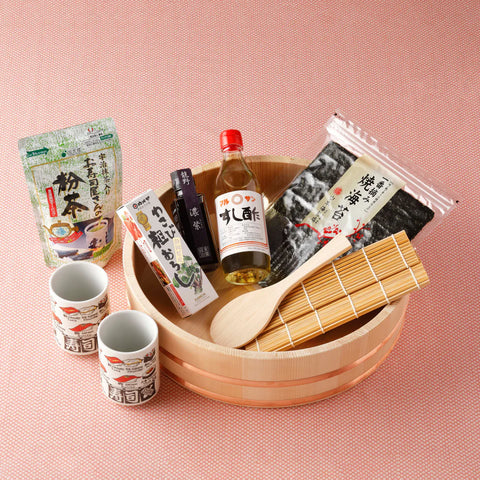
You’ll need some type of sushi bowl like a sushi oke (or a regular large bowl) for mixing the sushi rice in. You’ll also need a rice paddle to make sure that the rice grains don’t break apart or become mushy. For making sushi rolls, you’ll of course need a sushi rolling mat and some saran wrap to make the rolling process less messy.
If you want to make sushi like a pro at home, then our J Taste Sushi Making Kit has everything you need to recreate the most authentic sushi experience at home. If you specifically want to make nigiri sushi at home, then we also recommend this sushi making device. Looking for more sushi making advice? Definitely be sure to check out this article about how to throw the ultimate sushi party.
Nigiri

The most classic type of sushi is nigiri sushi which, as mentioned, consists of bite-sized rice portions topped with various ingredients, usually slices of sashimi. Oftentimes, a dab of wasabi is nestled in between the sushi rice and fish, but you can omit this if you’d like. The term "nigiri" translates to "hand-pressed," indicating that this sushi is formed by hand. Slicing the sashimi requires a sharp knife and a bit of skill, but you can also use presliced sashimi sold in your local Japanese or Asian grocery store. Don’t want to use raw fish or seafood? No problem! Feel free to use your favorite veggies like avocado, or even go for some marinated tofu.
Makizushi
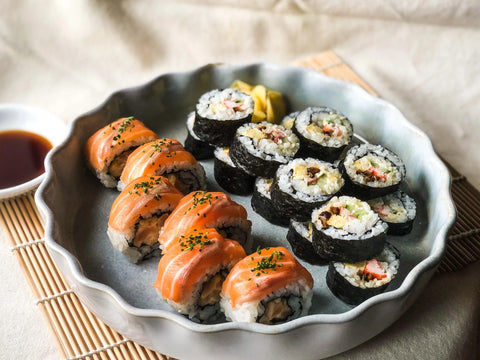
The next most popular type of sushi is makizushi or sushi rolls. This style of sushi may be more popular abroad and can be found in many sushi restaurants overseas. You can also make it at home easily with the right ingredients and equipment. We’ve shared our makizushi recipe on our website, showing you how to make the original makizushi and ura maki or inside-out roll. Why not try making both with our recipe?
Temaki Sushi
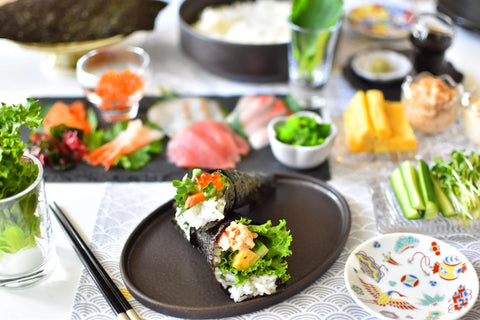
Another popular style of sushi, usually enjoyed at home in Japan is temaki sushi or hand rolls. As the name suggests, these sushi rolls are made by hand by taking a piece of nori seaweed and placing rice and sushi toppings inside. Want to try making it at home? Be sure to check out our recipe where we provide all the tips and tricks for making it!
Chirashi Sushi
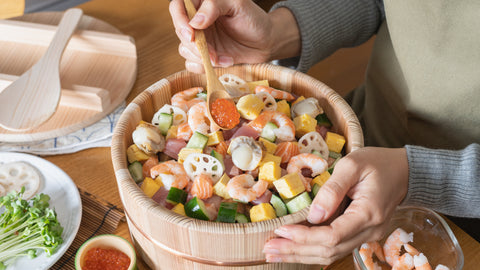
Chirashi sushi or “scattered sushi” consists of cooked rice mixed with vinegar and other seasonings, topped with ingredients such as eggs, vegetables, and sashimi. It’s always arranged in a beautiful way, making it customary in Japan to enjoy during festive occasions like Hinamatsuri (Dolls' Festival) on March 3rd, entrance ceremonies, and birthdays. However, you don’t need an excuse to enjoy this gorgeous sushi dish, feel free to enjoy it during any time of the year! You can even use a premade chirashi sushi kit to make the prep work easier.
Inari Sushi

Inari sushi is a great option for vegetarians, vegans, and tofu lovers! All you need is some sushi rice and preseasoned deep-fried tofu pockets (aburaage). Simply spoon your sushi rice inside of these sweet, umami-packed tofu pouches and you’re good to go!
Temari Sushi
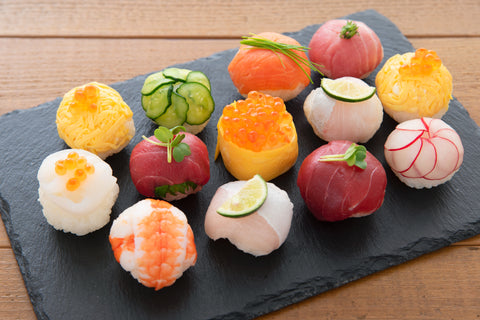
Temari sushi, or sushi balls are an aesthetically pleasing way to enjoy sushi. The name "temari" refers to traditional Japanese handball toys, which are small and intricately embroidered. Temari sushi is meant to have a similar visual appeal as vibrant toppings are placed overtop sushi rice balls. The process is similar to making nigiri, but the sushi rice portions are instead rolled into balls. The desired sushi toppings are then placed overtop and plastic wrap is often used to help create the perfect round shape.
Where To Buy Sushi Grade Fish?
To buy sushi-grade fish, you can visit local fish markets or seafood markets, particularly those near coastal areas, which often offer the freshest selections. Japanese grocery stores like Mitsuwa and H Mart, as well as specialty seafood stores, are also reliable sources. Additionally, upscale supermarkets such as Whole Foods and Wegmans might have sushi-grade options. Always ensure the fish is handled and frozen correctly to maintain safety and quality.
There are so many more sushi recipes out there, but we’ll leave it at this (for now)! Which sushi recipe was your favorite? Are there any sushi recipes you’d like to see on Japanese Taste? Be sure to let us know in the comments below. Also for more Japanese recipes, check out our recipe page.


0 comments